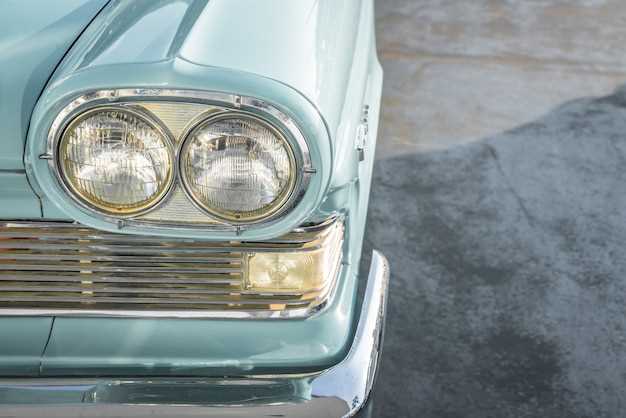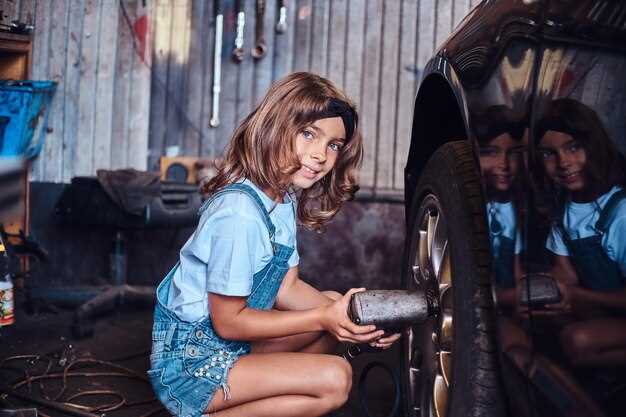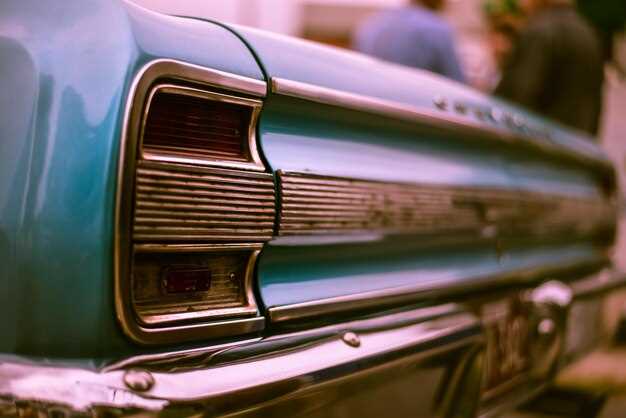
For enthusiasts and collectors of classic muscle cars, the allure of these iconic vehicles often comes with the risk of counterfeit components. The market is flooded with fake parts, which can undermine the authenticity and value of a prized automobile. Understanding how to identify these imitations is crucial for anyone looking to make a sound investment in a muscle car.
In the realm of classic automobiles, originality is paramount. Many collectors seek out vehicles that retain their original parts, as this significantly affects both functionality and resale value. However, fake parts can be expertly disguised, making it increasingly difficult for buyers to discern authenticity. Knowledge of the common types of counterfeit components and the associated signs of fraud is essential for anyone entering this competitive market.
As we dive deeper into this topic, we will explore several strategies to identify fake parts in classic muscle cars. By equipping yourself with the right information, you can navigate the complexities of the marketplace and protect your investment from the pitfalls of counterfeit components. Whether you are a seasoned collector or a first-time buyer, being vigilant about the authenticity of parts will ensure you acquire a genuine piece of automotive history.
Understanding the Common Types of Fake Parts
When it comes to vintage muscle cars, the authenticity of parts is crucial for both performance and value. Unfortunately, the market is rife with fake parts designed to deceive unsuspecting buyers. Recognizing these counterfeits is essential for any classic car enthusiast.
One common type of fake part is reproduction components. These are newly manufactured but designed to mimic original parts closely. While some reproductions are marked as such, others may be presented as genuine, misleading buyers into believing they are acquiring authentic vintage parts. It’s vital to assess the build quality and markings on these components.
Another prevalent form of deception involves altered or restamped parts. Original components may have their serial numbers ground off or changed to make them appear more desirable or rare. Scrutinizing the part’s finish, wear patterns, and any identifiable manufacturing marks can help discern their true nature.
Fake performance parts also pose a significant risk. Aftermarket modifications claiming to enhance the vehicle’s performance may, in reality, be of inferior quality and can detract from the car’s original function and value. It’s crucial to research and verify the reputation of performance upgrades before making a purchase.
Lastly, be aware of the trend of counterfeit branded items, which involve replicas produced to imitate well-known brands associated with muscle car parts. These items may lack the quality and reliability of authentic products, making it essential to purchase from reputable sources.
Understanding these common types of fake parts empowers classic car buyers to make informed decisions and protect their investments in vintage vehicles. Knowledge and vigilance are key to ensuring authenticity in muscle car purchases.
Key Identification Techniques for Authentic Components

When purchasing vintage muscle cars, verifying the authenticity of parts is crucial. Knowing key identification techniques will help buyers avoid counterfeit components that may compromise the vehicle’s integrity and value.
1. Research Original Part Numbers
Every authentic vintage part comes with a unique part number. Cross-referencing this number against manufacturer databases or reputable online resources can confirm legitimacy. Genuine parts usually bear markings that indicate their origin, making this a straightforward verification step.
2. Inspect Material Quality
Original components are manufactured with specific materials that reflect their era. Analyze the weight, texture, and finish of the parts. High-quality metals, plastics, or rubber should feel durable and not brittle. Counterfeit parts often skimp on material quality to reduce costs.
3. Evaluate Manufacturing Techniques
Authentic vintage parts often exhibit specific manufacturing techniques, such as stamping, welding, or casting. Familiarize yourself with these processes to identify discrepancies. For example, poorly executed welds or mismatched casting numbers can indicate a counterfeit component.
4. Check for Manufacturer Logos and Markings
Genuine parts frequently bear manufacturer logos, date codes, or trademarks. Look for consistent branding and placement of these identifiers. Fake components may have poorly executed logos or incorrect placements, which can be a dead giveaway of inauthenticity.
5. Consult Expert Forums and Communities
Joining forums or communities dedicated to classic muscle cars can provide invaluable insights. Experienced collectors and restorers often share their knowledge about specific parts, including details on identifiers. Engaging with these experts can aid in identifying authentic parts.
6. Utilize Professional Appraisal Services
When in doubt, consider hiring a professional appraiser specializing in vintage muscle cars. Their extensive knowledge and experience can help verify the authenticity of parts, ultimately safeguarding your investment.
By employing these identification techniques, buyers can confidently assess the authenticity of vintage parts, ensuring that their classic muscle car remains a true piece of automotive history.
Utilizing VIN and Original Documentation for Verification

When purchasing a vintage muscle car, verifying the authenticity of its parts and overall integrity is crucial. One of the most effective ways to authenticate a classic vehicle is through the Vehicle Identification Number (VIN) and the original documentation associated with the car.
The VIN serves as the unique identifier for each vehicle, much like a fingerprint. Here’s how to utilize the VIN effectively:
- Decoding the VIN: Each section of the VIN contains specific information about the car’s make, model, engine type, and year of manufacture. This information can help ensure that the car’s parts are consistent with its original specifications.
- Cross-Referencing: Use the VIN to cross-reference documentation, such as build sheets and manufacturer records. This helps confirm that the parts on the car match the original configuration.
- Checking for Alterations: Look for discrepancies such as mismatched components or alterations that could indicate replacement parts rather than original vintage parts.
In addition to the VIN, original documentation plays a pivotal role in verifying the car’s authenticity:
- Build Sheets: These documents provide insight into the vehicle’s assembly and can confirm the presence of original parts.
- Purchase History: Records of previous ownership can reveal if any critical components have been replaced and help establish the car’s provenance.
- Service Records: Maintenance files can show whether the car has been properly cared for, adding further credibility to its overall condition.
By diligently utilizing both the VIN and original documentation, potential buyers can significantly minimize the risk of investing in a classic vehicle with counterfeit or inferior parts. This rigorous approach not only protects financial investments but also preserves the legacy of vintage muscle cars.
Recognizing Red Flags During a Purchase Inspection
When inspecting a vintage muscle car, it is crucial to be vigilant for signs of fake parts that may compromise the vehicle’s authenticity and value. One of the first red flags to look for is uneven wear on components. A genuine vintage car will show signs of aging consistent with its mileage, whereas fake parts might appear too new or show excessive wear in odd places.
Next, check for mismatched serial numbers. Original parts typically have unique identification numbers that correspond to the vehicle’s build sheet. If you find parts with serial numbers that do not match or appear inconsistent with the model’s specifications, it’s a significant warning sign that those parts may be counterfeit.
Inspect for modification signs. Many vintage muscle cars may have undergone restorations or modifications, but if you notice excessive or poorly executed alterations, it could indicate the presence of fake components. Look for non-original fasteners, misaligned panels, or questionable welding that deviate from factory specifications.
Don’t overlook the importance of documentation. A reputable seller should provide paperwork verifying the car’s history, including ownership records and restoration details. Lack of proper documentation can indicate that parts have been switched out or replaced with fake alternatives.
Furthermore, assess the overall condition of the vehicle against its purported history. If a car is advertised as a meticulously maintained classic but has rust issues or other signs of neglect, it could suggest that some parts have been replaced with inferior, fake options.
Finally, listen to your instincts. If something feels off during the inspection, do not hesitate to conduct further research or seek expertise from a knowledgeable professional. The protection of your investment hinges on your ability to recognize these red flags during the purchase inspection.
Consulting Experts: When to Seek Professional Help
When purchasing classic muscle cars, the risk of encountering fake parts is a significant concern for buyers. While some individuals possess a keen eye for detail, others may find it challenging to differentiate between authentic components and replicas. In such cases, consulting experts is crucial to ensure an informed investment.
One of the primary reasons to seek professional help is the complexity of classic car parts. Many components have specific markings, production dates, and unique characteristics that can be easily overlooked by an untrained eye. Experts, such as certified appraisers or classic car restorers, are equipped with the knowledge to identify genuine parts and flag potential fakes, saving buyers from costly mistakes.
Additionally, if a deal seems too good to be true, it often warrants further inspection. Professionals can conduct thorough evaluations of the vehicle, including provenance verification and condition assessments, which are essential for understanding the authenticity of parts. Their expertise can unveil issues that may not be immediately visible, providing peace of mind to buyers.
Finally, when dealing with rare or high-value classic muscle cars, the stakes are high. Engaging an expert not only helps in identifying fake components but also ensures that the overall integrity of the vehicle is maintained. This investment in professional guidance can enhance the car’s value and enjoyment for years to come, making it a worthwhile consideration for any serious collector.
Maintaining Value: Best Practices Post-Purchase
After acquiring a classic muscle car, ensuring its value remains intact requires vigilant care and attention to detail. The presence of fake parts can significantly diminish the worth of your vehicle, so here are some best practices to maintain its value:
| Best Practice | Description |
|---|---|
| Documentation | Keep all purchase receipts, maintenance records, and any history that validates the authenticity of the parts used in your car. This helps in establishing provenance and can support resale value. |
| Regular Maintenance | Consistent servicing by professionals who are knowledgeable about classic cars prevents deterioration. Use authentic OEM parts whenever necessary to avoid introducing fake components. |
| Community Engagement | Participate in classic car clubs and forums. Networking provides valuable insights and can help in identifying trustworthy sources for genuine parts. |
| Invest in Quality Parts | When replacements are needed, opt for high-quality, authentic parts. Using fake components can undermine a car’s structural integrity and authenticity, affecting its value. |
| Climate-Controlled Storage | Store the vehicle in a climate-controlled environment to protect it from rust, fading, and other environmental damage that can lead to diminished value. |
By adhering to these practices, collectors can safeguard their investment against the pitfalls of fake parts and ensure that their classic muscle car retains its charm and value over time.




